|
LAS
ARBOLEDAS, A NEW TOWN IN CUBA
|


|
Principal
Concepts of the General Plan:
(Much of
the following discussion of delsign concepts is from "Las Arboledas
Sketchbook, Design for a New Community in Cuba")
|
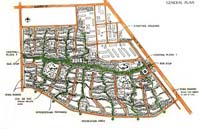
16.
Las Arboledas General Plan.
|
Pedestrian Community.
Las Arboledas is designed to be a pedestrian community which
is connected to the larger urban area by bus and auto.
The pedestrian community provides an intimate social environment
where children, for example, can walk to school, to the store,
or to visit friends without crossing busy streets. Homes
are sheltered from noise with only quiet pedestrian paths passing
in front of them. Apartments are grouped into neighborhood
clusters of about 50 apartments with public community
space in front including meeting spaces, small plazas, walkways,
and green areas. The community is connected internally
by pedestrian paths (green color) and with other parts of the
city by bus or car. No through streets cross and disrupt
the community. A ring road (tan color) circles it providing
easy vehicular access to and from other parts of the city. A
series of finger roads (tan color) provide vehicular access
to the interior of the community, while protecting it from fast
traffic.
|
|

17.
Shaded pedestrian boulevard in Havana.
|
The result is that it is easy to go from place to place within the
community on foot and easy to get from the community to another
part of the city by bus (or car), but it is not possible to use
the community as a thoroughfare. The community is a destination
or a starting point, but never a passageway.
These patterns integrate both social and energy concerns.
For example, the intimate community that is created by a pedestrian
circulation system also has a major impact on energy use. In California,
where we have designed our towns around the car, transportation
in the 90s consumed 47% of the state's energy. When we started
Las Arboledas, 86% of the trips people made in Havana were by
bus, while 6% were by car. Yet Havana's cars consumed the same
amount of fuel annually as the buses. In other words, the buses
provide 14 times as much transportation service as the cars with
the same amount of fuel.
|

18.
Typical full bus in Havana. The man in the doorway isn't
getting on. He is on.
19.
U.S. traffic jam.
By
James A. Parcell - The Washington Post
|
Although 94% of trips are by means other than cars, many Cuban
planners were basing their designs on the car. It made sense
from their perspective. Cuba was developing rapidly.
With the U.S. as a prime example, cars would seem to be a symbol
of development and the future.
On the other hand, American planners, living in a society dominated
by the car, have become increasingly concerned with its drawbacks:
|
|
20.
Most Cubans don't have a car.
|
For people
with few cars, as in Cuba, the drawbacks of cars are not obvious.
The idea of a pedestrian community seemed backward
(they already walked).
However, after lengthy deliberations, which included both technical
analyses, a sociological study and discussions with the people
who would live in Las Arboledas, the government decided to make
it a pedestrian community as a demonstration project.
A
pivotal point in this discussion occurred when auto advocates
noted that by adding only a few hundred feet of road, the finger
roads could be connected and made in to through streets.
This would clearly be easier for cars. Since we knew who
the occupants of Las Arboledas would be, we were able to interview
them about this. We asked them what they preferred.
The through streets would make it easier for cars to get around.
On the other hand, there would be more and faster traffic, it
would be noisier, less safe for kids and less intimate.
People were quite clear that they preferred a more intimate neighborhood
protected from cars.
|
|

21.
.

22. Cuba bought 200,000 bikes after the collapse of the Soviet
Union cut its oil supply in half.
|
As
already noted, building a non-car oriented future was controversial
when we started. When we talked about bicycles, the attitude
was that this might be OK for people in the countryside but not
for sophisticated Habaneros. However, shortly after construction
started on Las Arboledas the Soviet Union began to come apart.
80% of Cuba's foreign trade was disrupted and its supply of oil
was cut in half. Previous assumptions that Cuba could plan
for growing use of oil were clearly not viable. Fast adjustments
were necessary. In 1991 the Cuban government traded sugar
for 200,000 bicycles from China starting a major change in orientation
toward transport. Within a year Havana became a strongly
bicycle oriented city.
|
 23.
2 centers connected by pedestrian boulevard. 23.
2 centers connected by pedestrian boulevard. |
Lively Town Centers
There are two centers planned for Las Arboledas, one for each 10,000 people.
The furthest residence is within 1300 feet of a center, easy walking
distance.
|
 24.
Town center. 24.
Town center. |
The centers consist of a central plaza surrounded by the community
services: market, pharmacy, cafeteria, meeting rooms, social area,
etc. In a typical Cuban community these services are normally
very minimal. We are proposing ways to increase the intensity
of activity at low cost, in particular by including outdoor and
semi-outdoor activities. For this purpose we have incorporated
a farmer's market and an open air cinema into the community center.
The two community centers are linked by a pedestrian boulevard
along which are placed the schools, playgrounds, and certain other
lower intensity public uses as well as some housing. The centers
are close to a bus stop and the major street to central Havana.
In this way, most people will pass through or close to the central
plaza on their way to and from other parts of the city, on their
way home from work, returning from shopping in the city center,
etc. |

25. Natural Landscape of Las Arboledas.
|
Preservation
of the Local Environment
The site is quite beautiful with numerous large trees, mango orchards,
and rolling hills. One of our objectives is the preservation of
this landscape and its integration with the new community.
As we discovered and will explain later, this had an impact well
beyond the trees themselves affecting the quality of design and
work throughout the project. |
|
However, in discussing the value of the natural landscape, we often
think in aesthetic terms and these concerns can seem small in the
face of the bulldozer. Builders often prefer to clear all the trees
and level the ground, especially when heavy equipment is used, arguing
that it is cheaper. Since we feel that destruction of the natural
environment is in fact a gross economic error, we pointed out some
of the more concrete benefits of preserving it. One example
is the impact on the microclimate. |

26.
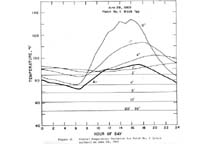 27. Temperature of blacktop during course
of the day.
27. Temperature of blacktop during course
of the day.

28.
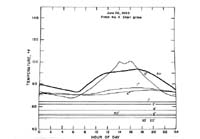 29. Temperature of grass surface during course of the day.
29. Temperature of grass surface during course of the day.
|
Microclimate:
Landscaping for Energy Savings
In Cuba's
tropical climate, buildings can become very hot and uncomfortable.
Most Cubans do not have air conditioning but as their incomes
rise they will want it if buildings are uncomfortable.
This will increase energy use and the environmental problems that
go with it. In addition, air conditioning then competes
for energy resources with more basic economic development such
as industry and agriculture. One of our objectives has been
to design buildings that are naturally cool and thereby eliminate
this potential energy drain.
The landscape can play an important role in cooling buildings
and in creating a more comfortable microclimate. Part of this
effect is illustrated rather clearly in a series of tests done
by the U.S. National Bureau of Standards in the southern U.S.
(NBS Report 10373, February 1, 1971) These tests measured the
surface temperatures of a blacktop surface and a grass covered
surface during the 24 hours of the day. On a summer afternoon,
when the air temperature had risen to 90 degrees, the surface
of the blacktop had risen to over 130 degrees. In addition it
stored this heat and so remained hotter than the surrounding air
even during the night. In contrast, a grass covered surface nearby
barely reached 90 degrees at its hottest and during most of the
day and night was more than 12 degrees cooler than the surrounding
air.
|
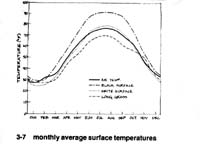 30. Ttemperatures of grass & blacktop surfaces over
the year.
30. Ttemperatures of grass & blacktop surfaces over
the year.
|
Figure 30 shows the average monthly temperatures throughout the
year for the blacktop surface, the grass surface, and the surrounding
air. The blacktop is consistently hotter than the air, while the
grass is consistently cooler. During the summer the grass was more
than 10 degrees cooler than the blacktop. In fact it is well known
that cities, with these asphalt "solar collectors", are hotter than
the surrounding rural areas. |
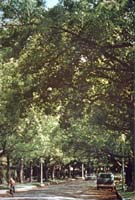 31.
31.
|
Shaded Streets
Trees and plants are important in creating and maintaining a thermally
comfortable environment. These particular tests suggest that we
should minimize paved surfaces. But we cannot eliminate them entirely,
so what can we do? One answer is to shade the streets with large
trees. But these trees cost money to plant and maintain. In addition
they can easily take 20 years or more to reach the required size.
|

32. Trees on site. |
Our
site already has many large trees with a great value, all we have
to do is preserve them. This then is one of many motives for taking
care of the existing natural setting. |

 
· home
· projects · bulletin
board · links · who
are we · contact ·
webdesign by
Ari
Goldstein
|
|

